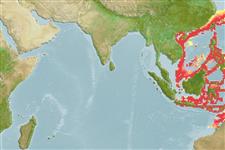Environment: milieu / climate zone / depth range / distribution range
Ecologia
marinhas demersal; intervalo de profundidade 60 - 142 m (Ref. 5222). Tropical; 31°N - 17°S, 106°E - 126°E (Ref. 5222)
Eastern Indian Ocean and Western Pacific: known only from southern Japan, Hong Kong, Hainan Islands of China, Viet Nam, South China Sea, Java, and northwest Australia. Record from Taiwan (Ref. 6864) is dubious.
Tamanho / Peso / Idade
Maturity: Lm ? range ? - ? cm
Max length : 33.0 cm SL macho/indeterminado; (Ref. 5222)
Espinhos dorsais (total) : 11; Raios dorsais (total) : 15 - 16; Espinhos anais: 3; Raios anais : 8. Preopercle with 1 - 4 distinctly enlarged serrae at its angle; upper edge of the operculum straight; nostrils subequal. Pectoral fins not fleshy. Pyloric caeca 12. Body and head yellowish brown dorsally, whitish ventrally, with numerous small dark brown to black dots on the upper sides, and 5 faint oblique bars, which may disappear in preservative; the chest and ventral parts of the head pale reddish orange. The fins are pale, with the rays darker than the membrane; the soft dorsal and caudal fins with narrow dark brown margin.
Found on the continental shelf (Ref. 75154), over mud and sand substrata (Ref. 89707). Caught by trawling at depths ranging from 37 to 142 m. The small size and poor edible quality probably accounts for its low value in the markets.
Ciclo de vida ou comportamento de acasalamento
Maturidade | Reprodução | Desova | Ovos | Fecundidade | Larvas
Heemstra, P.C. and J.E. Randall, 1993. FAO Species Catalogue. Vol. 16. Groupers of the world (family Serranidae, subfamily Epinephelinae). An annotated and illustrated catalogue of the grouper, rockcod, hind, coral grouper and lyretail species known to date. Rome: FAO. FAO Fish. Synop. 125(16):382 p. (Ref. 5222)
Status na Lista Vermelha da UICN (Ref. 130435: Version 2024-2)
Ameaça para os humanos
Harmless
Uso pelos humanos
Pescarias: pouco comercial
Ferramentas
Relatórios especiais
Baixar XML
Fontes da internet
Estimates based on models
Preferred temperature (Ref.
123201): 17.9 - 26.6, mean 22.5 °C (based on 79 cells).
Índice de diversidade filogenética (Ref.
82804): PD
50 = 0.5000 [Uniqueness, from 0.5 = low to 2.0 = high].
Bayesian length-weight: a=0.01175 (0.00568 - 0.02430), b=3.04 (2.88 - 3.20), in cm total length, based on LWR estimates for this Genus-body shape (Ref.
93245).
Nível Trófico (Ref.
69278): 3.8 ±0.6 se; based on size and trophs of closest relatives
Resiliência (Ref.
120179): médio(a), tempo mínimo de duplicação da população 1,4 - 4,4 anos (Preliminary K or Fecundity.).
Fishing Vulnerability (Ref.
59153): Low to moderate vulnerability (30 of 100).
